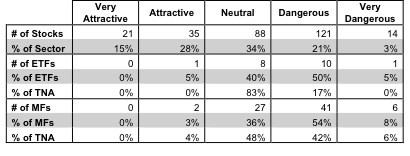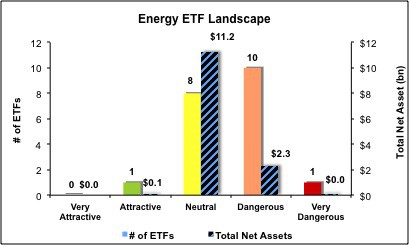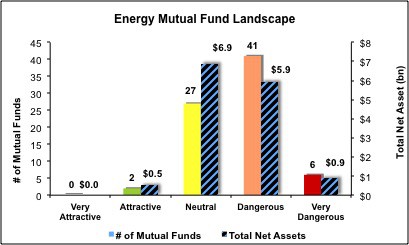The Energy sector ranks sixth out of the ten sectors as detailed in my sector roadmap. It gets my Neutral rating, which is based on aggregation of ratings of 20 ETFs and 76 mutual funds in the Energy sector as of July 12, 2012. Reports on the best & worst ETFs and mutual funds in every sector and style are here.
Figures 1 and 2 show the five best and worst-rated ETFs and mutual funds in the sector. Not all Energy sector ETFs and mutual funds are created the same. The number of holdings varies widely (from 24 to 171), which creates drastically different investment implications and ratings. The best ETFs and mutual funds allocate more value to Attractive-or-better-rated stocks than the worst ETFs and mutual funds, which allocate too much value to Neutral-or-worse-rated stocks.
To identify the best and avoid the worst ETFs and mutual funds within the Energy sector, investors need a predictive rating based on (1) stocks ratings of the holdings and (2) the all-in expenses of each ETF and mutual fund. Investors need not rely on backward-looking ratings. My fund rating methodology is detailed here.
Investors should not buy any Energy ETFs or mutual funds because none that meet our liquidity standards (total net assets > $100 million) get an Attractive-or-better rating. If you must have exposure to this sector, you should buy a basket of Attractive-or-better rated stocks and avoid paying undeserved fund fees. Active management has a long history of not paying off.
See ratings and reports on all ETFs and mutual funds in this sector on my free mutual fund and ETF screener.
Figure 1: ETFs with the Best & Worst Ratings – Top 5
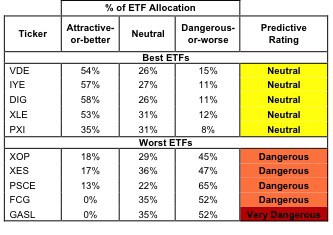 * Best ETFs exclude ETFs with TNA’s less than 100 million for inadequate liquidity.
* Best ETFs exclude ETFs with TNA’s less than 100 million for inadequate liquidity.
Sources: New Constructs, LLC and company filings
PowerShares Dynamic Energy E&P (PXE) and Focus Morningstar Energy Index ETF (FEG) are excluded from Figure 1 because their total net assets (TNA) are below $100 million and do not meet our liquidity standards.
Figure 2: Mutual Funds with the Best & Worst Ratings – Top 5
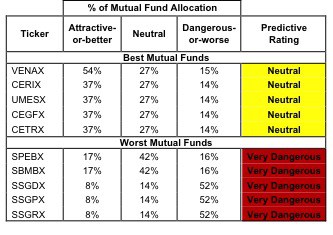 * Best mutual funds exclude funds with TNA’s less than 100 million for inadequate liquidity.
* Best mutual funds exclude funds with TNA’s less than 100 million for inadequate liquidity.
Sources: New Constructs, LLC and company filings
Five mutual funds are excluded from Figure 2 because their total net assets (TNA) are below $100 million and do not meet our liquidity standards.
Vanguard Energy ETF (VDE) is my top-rated Energy ETF and Vanguard World Funds: Vanguard Energy Index Fund (VENAX) is my top-rated Energy mutual fund. Both earn my Neutral rating.
Direxion Daily Natural Gas Related Bull 3x Shares (GASL) is my worst-rated Energy ETF and BlackRock Funds: BlackRock Energy & Resources Portfolio (SSGRX) is my worst-rated Energy mutual fund. Both earn my Very Dangerous rating.
Figure 3 shows that 56 out of the 279 stocks (42% of the total net assets) held by Energy ETFs and mutual funds get an Attractive-or-better rating. However, only 1 out of 20 Energy ETFs (less than 1% of total net assets) and 2 out of 76 Energy mutual funds (4% of total net assets) get an Attractive-or-better rating.
The takeaways are: Energy sector mutual fund managers and ETFs are picking the wrong stocks in this sector. Their fees are undeserved, no matter how low.
Figure 3: Energy Sector Landscape For ETFs, Mutual Funds & Stocks
As detailed in “Cheap Funds Dupe Investors”, the fund industry offers many cheap funds but very few funds with high-quality stocks, or with what I call good portfolio management.
Investors need to tread carefully when considering Energy ETFs and mutual funds, as 95% of ETFs and 97% of mutual funds are not worth buying. Only 1 ETF and 2 mutual funds in the Energy sector allocate enough value to Attractive-or-better-rated stocks to earn an Attractive rating.
Western Refining, Inc (WNR) is one of my favorite stocks held by Energy ETFs and mutual funds and earns my Very Attractive rating. WNR’s return on invested capital (ROIC) of 20% places them in the 90th percentile of all Russell 3000 companies and demonstrates management’s ability to effectively allocate capital. And yet the market is bearish on the stock. WNR’s current stock price (~$23) implies that after-tax profits (NOPAT) will permanently decrease by 60%. Strong past performance coupled with the market’s overly pessimistic view of future performance makes WNR an excellent long candidate.
Carrizo OIL & Gas, Inc. (CRZO) is one of my least favorite stocks held by Energy ETFs and mutual funds and earns my Very Dangerous rating. CRZO has a long track record of value destruction. Not once in the 14 years I’ve covered the company has it generated an ROIC over its weighted average cost of capital (WACC). During the same period, the company has written off 20 cents for every dollar that had been invested in the business. In spite of its poor past performance, the market has optimistic future expectations. To justify its current stock price (~$23.41), CRZO must grow its profits by 15% compounded annually for 20 years. Lofty expectations and poor past performance offer investors a poor risk/reward trade-off here.
190 stocks of the 3000+ I cover are classified as Energy stocks, but due to style drift, Energy ETFs and mutual funds hold 279 stocks.
Figures 4 and 5 show the rating landscape of all Energy ETFs and mutual funds.
Our sector roadmap report ranks all sectors and highlights those that offer the best investments.
Figure 4: Separating the Best ETFs From the Worst ETFs
Figure 5: Separating the Best Mutual Funds From the Worst Mutual Funds
Review my full list of ratings and rankings along with free reports on all 20 ETFs and 76 mutual funds in the Energy sector.
Disclosure: I own WNR. I receive no compensation to write about any specific stock, sector or theme

